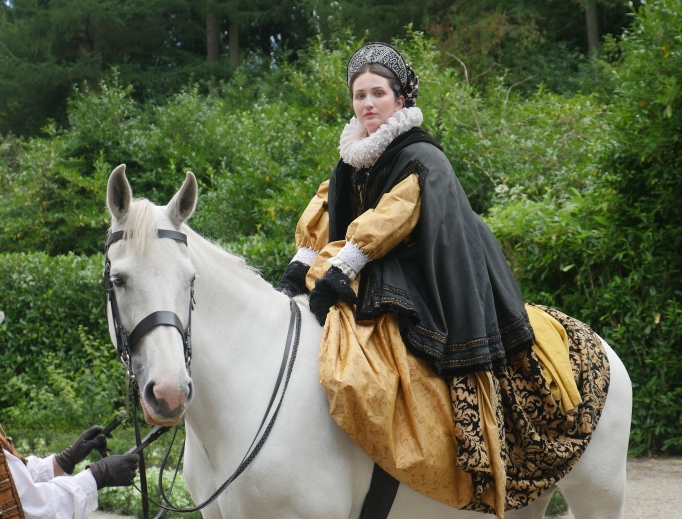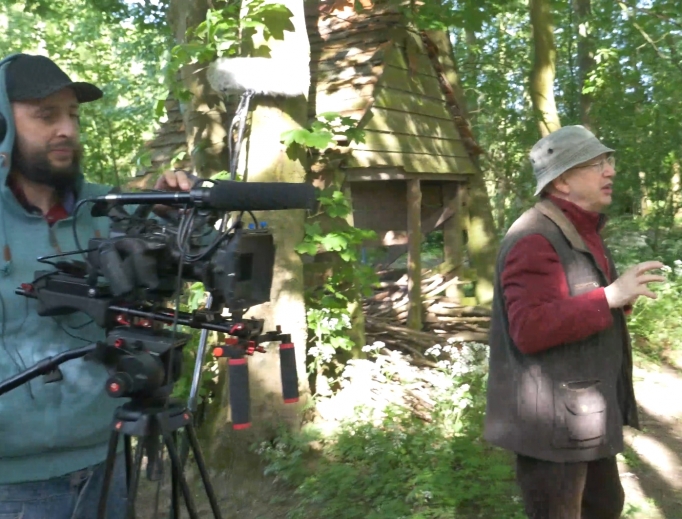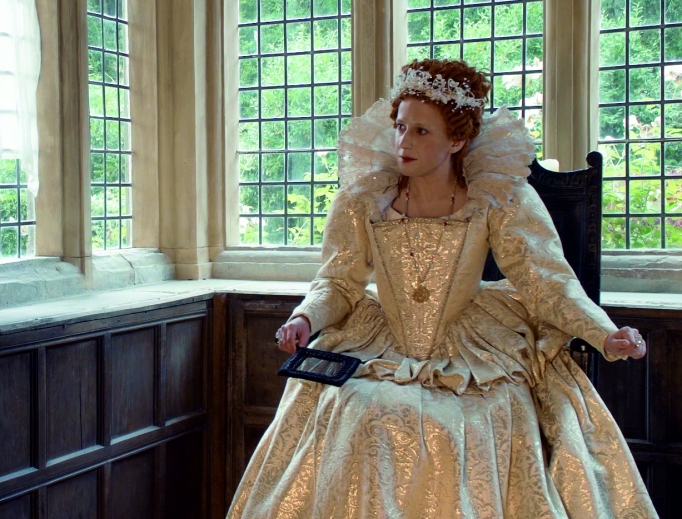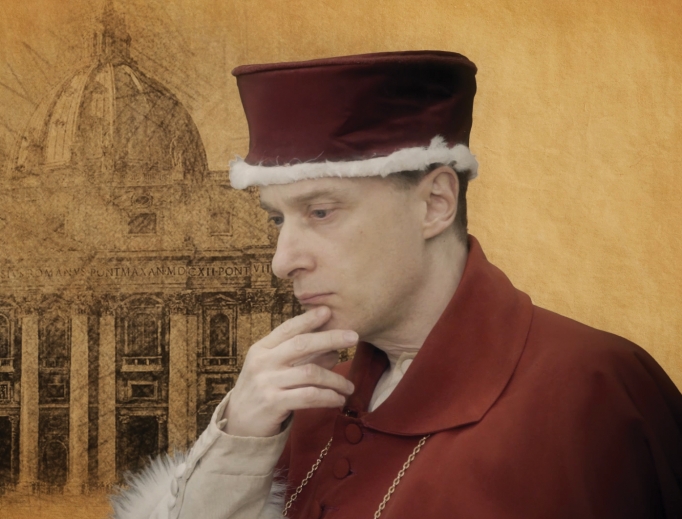‘The Reformation’ Comes to EWTN
New 12-part docudrama brings the 16th century to life on screen.

The Reformation, a new docudrama produced by Eternal Word Television Network (EWTN), debuts around the world in May.
Having completed docudramas for EWTN on, among other subjects, Fatima and the Crusades, director Stefano Mazzeo is not fazed by the challenge of such a sweeping historical epic as The Reformation. In fact, Mazzeo appears to relish the prospect, seeing these EWTN projects as debunking myths about key moments in history, moments often used for propaganda purposes against the Church. For this latest series, he views his cinematic brief as “ telling Catholics and others how the Church formed Christian Europe and [in this series of The Reformation] how Luther destroyed the impact of Christianity on Europe.”
EWTN green-lit The Reformation in October 2014, but Mazzeo was busy with other film commitments at that time. Therefore, it was not until May 2018 that filming finally got underway at Kentwell Hall, a 16th-century stately home in Suffolk. Before any camera started shooting, however, Mazzeo had been researching for months the historical and theological context of the 16th-century Protestant Revolt.
“I’ve been researching this project since the start in 2014,” he told the Register. “And there is never a time when the research is finished. Even now, in post-production, I’m still working on the linking narration.” Mazzeo feels that a multipart series is the perfect vehicle through which to fully tell the story of the Reformation and bring alive the characters involved in it. “With a feature film it’s possible to explore figures such as Luther, but in a docudrama series you get to explore subjects even more fully than in either a documentary or a feature film.” He then added, with a smile, “For example, we had a very good actor playing Henry VIII. So, for me, on screen I felt like a lawyer who has nailed the suspect — ‘I’ve got you where I want you: Now, tell the truth!’”
Authentic Reformation
A television series like The Reformation involves many people, from the cast to those involved in the many facets of production. From its beginning, the series’ associate producer, Ellen Plumridge, was involved in diverse aspects of the production. Working closely with Mazzeo, she sourced locations and props, collaborated with him in the casting of actors and helped with the logistics involved in staging the epic battle scenes.
Needless to say, in any historical epic, costumes are key to the look and feel of the production. This task also fell largely to Plumridge. Speaking to the Register, she agreed it was a challenge: “There were many hours of research from books, paintings and, of course, the internet. I became almost a permanent fixture in the various costume houses in London!”
She spent days going through thousands of 16th-century costume designs, trying to find the right clothes for each character.
“The clothes needed to be of natural materials,” she said. “Man-made materials show very easily under good cameras; they don’t hang or move in the same way [as natural fabrics].” Plumridge’s attention to detail had to be meticulous. “For the peasants, muted colours were chosen, as they would have little access to rich materials, and any dyeing would have been carried out using local plants. Dressing the royal characters was wonderful, as I was able to leave all the peasant attire behind and dress the cast in beautiful outfits with jewels and headdresses, large hats with decorations for the gentlemen, with many trimmings. I particularly enjoyed the costumes for the various queens, as these were opulent. Queen Mary had a lovely riding outfit for her entrance, complete with pipers and a beautiful horse.”

The Mary, Queen of Scots character was outfitted in much finery.
Locations needed just as much research as the costumes. “The locations were difficult to source,” Plumridge admits, “because not only did we require the internals and externals to be correct, but we required the furniture, paintings, tapestries in situ to be correct; otherwise, it would have involved the hiring, transporting, and then the time-consuming setting up, of a large number of heavy props.”
Just watching the various battle scenes alone, with their need for many extras, period costumes and weapons, plus the marshalling of the various reenactment groups involved, shows the extent of the logistics behind the making of The Reformation. Alongside these considerations, speed was always of the essence in the making of this series. For example, on one day alone, a dozen actors performed in 14 scenes.

Stefano Mazzeo is shown directing a scene.
Real Play
So what was it like to act in The Reformation? Monica Nash played Queen Elizabeth I. She told the Register, “Elizabeth I is such a famous and well-known figure in world history, so I already knew quite a bit about her prior to playing her; and, of course, she has been played by many wonderful actresses on stage, TV and film before. Rather than study the interpretations of others, though, I focused on what I could, uniquely, bring to the role myself.”
That meant starting with the script, mining it for any clues to their character, and after that, as Nash said, it was “bringing those qualities into the body.” She went on to explain, “The most informative aspect of getting into character was actually when I got the costume and wig on. It affects everything about how you behave: the speed at which you can move, how far you can turn your head, how you sit, how easily you can breathe. Elizabeth’s clothes were so restrictive to wear and so glorious to look at that, as soon as you start to move around in them, you get an immediate feel for what it was like to be her.”

Monica Nash portrays Queen Elizabeth I.
Entering into the mindset of the Protestant Elizabeth I brought interesting insights for the Catholic actress. “I think it’s tempting for many people, especially Catholics, to see Elizabeth as a ‘baddie’ who irrevocably damaged the country through her actions,” she said. “But when you’re playing these people, you can’t think like that. She was not a cartoon villain but a real person who had hopes, disappointments, triumphs and suffering.” She added, “There’s nothing like playing these characters to make you less inclined to judge them.”
Tony Plumridge, Ellen’s husband, was The Reformation’s assistant director and production manager, and he also played the part of St. Thomas More in the series. Commenting on that role, Tony told the Register, “We shot the ‘cell’ scenes involving More at Hever Castle in Kent. The scenes came thick and fast, and after dressing the set, in one of the dungeon-like cellars, I had to rush up, get into costume, makeup, and then rush down.”
Thereafter, the director and actor had but a short time to try and evoke something of the martyr in his cell in the Tower of London. “On a shoot like this, a ‘flavor,’ a glance, a hint, a glimmer of possibilities, is all that one can hope to achieve,” he said, before adding, “I would have loved to had a three-week shoot in the cell, perhaps have gone ‘method’ [acting], and even slept there over night.” But even in the short time Tony had “in character” in the “cell” he felt he could sense the future saint’s detachment from “all the goods of this world” as he awaited his execution.
Concerted Effort
The Reformation consists of 12 episodes, each 30-minutes long. Beginning May 6, a new episode will run during the first week of each month until Oct. 31, a date remembered by some as “Reformation Day” and the day on which EWTN will broadcast all 12 episodes. Then, in March 2021, the network will broadcast as a weekly series all 12 episodes of The Reformation.

Pope Leo ponders building the new St. Peter's Basilica.
The Reformation has taken more than two and a half years to complete to date. At the time of writing, episodes seven-12 were still in post-production. Mazzeo has approximately 4,230 hours of footage from nearly two months of relentless filming on a variety of locations across Europe. It takes many hours of editing to turn this footage into the required 12 episodes. And it is not just the visual experience that is being created — many hours of music has also been scored for the soundtrack.
Mazzeo has always seen music as a central component to filmmaking. To enhance the look, feel and impact on an audience, he works closely with the film’s soundtrack composer, Adam Tucker. So where does the composer start?
“Ideally, I sit and watch the film,” Tucker told the Register. “And I start imagining, as I’m doing so, what sort of music is going to be needed — what sense of melody, of tempo, of instrumentation. The input from Stefano [Mazzeo] is vital at this stage, as he will have ideas already of what sort of music is going to be needed and in which scene. Sometimes he might offer a reference track for me to base my ideas upon, which can be useful, especially if I am struggling to understand exactly what sort of music he imagines being there.”
All the music, including the use of period instruments, was recorded at Tucker’s home studio in Coventry, England, with the only live recording being the various choral works used in the series. From the start of this latest project, Tucker was aware that Mazzeo is a director who uses “lots of music.”
Tucker explained, “For a series like this, I might be working on 40 separate pieces, amounting to 90 minutes of music.”
Transmission of Truth
After so much hard work, time and expense, the question remains how docudramas such as The Reformation fit into the overall mission of EWTN.
Speaking of the forthcoming series, Doug Keck, president and chief operating officer of EWTN, told the Register, “In an era where culture takes such a negative view on the Church and her history, it’s important that Catholics understand the truth of what really happened, similar to what we have done at EWTN before, in relation to the Crusades and also the Spanish Inquisition, not whitewashing what actually happened, but presenting the facts we know to be true. ‘Black legends’ have been used against the Church for years, becoming seeming fact in the popular historical secular culture of today. Docudramas like The Reformation are a perfect example of our attempts at EWTN to set the record straight.”
Keck sees these EWTN-produced docudramas as “fitting perfectly into the network’s mission of recatechizing Catholics in their faith” and, by so doing, ensuring today’s Catholics “are emboldened to stand up for their beliefs with the knowledge that they not only believe in the truth but have the truth of history behind them.”
K.V. Turley is the Register’s U.K. correspondent.
This story was updated after posting to reflect the most accurate series air dates.
- Keywords:
- ewtn
- k.v. turley
- the reformation
















